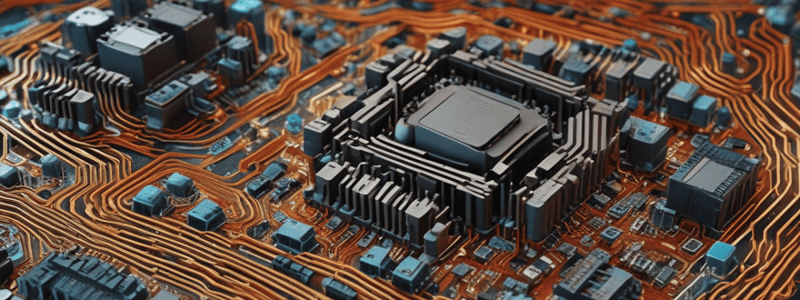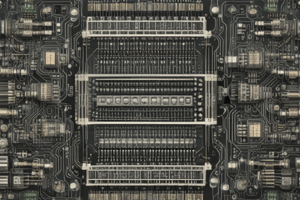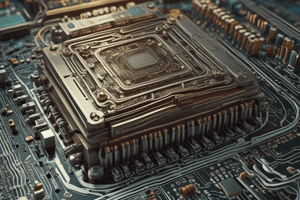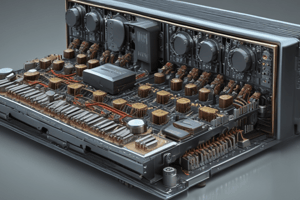Podcast
Questions and Answers
What is the main function of a diode?
What is the main function of a diode?
Allow current to flow in one direction only
What are the two main types of ICs discussed?
What are the two main types of ICs discussed?
Analog ICs and Digital ICs
What advantages do ICs offer over traditional discrete circuits?
What advantages do ICs offer over traditional discrete circuits?
Miniaturization, Reliability, Power Efficiency, and Cost-Effectiveness
What is the generation process of integrated circuits?
What is the generation process of integrated circuits?
What is the configuration of an inverting operational amplifier?
What is the configuration of an inverting operational amplifier?
What is the purpose of an operational amplifier (Op-amp)?
What is the purpose of an operational amplifier (Op-amp)?
What type of devices are op-amps considered in analog electrical circuits?
What type of devices are op-amps considered in analog electrical circuits?
What does the gain of the inverting amplifier depend on?
What does the gain of the inverting amplifier depend on?
What are some common mathematical operations that op-amps can perform?
What are some common mathematical operations that op-amps can perform?
In the non-inverting operational amplifier configuration, which input is connected to the input signal?
In the non-inverting operational amplifier configuration, which input is connected to the input signal?
How are the input terminals of an op-amp labeled?
How are the input terminals of an op-amp labeled?
Where is the feedback applied in a non-inverting amplifier?
Where is the feedback applied in a non-inverting amplifier?
What is the characteristic feature of op-amps related to input impedance?
What is the characteristic feature of op-amps related to input impedance?
Name one common application of the non-inverting amplifier.
Name one common application of the non-inverting amplifier.
What are some applications of the Op Amp IC 741?
What are some applications of the Op Amp IC 741?
What makes op-amps useful in circuits with multiple stages?
What makes op-amps useful in circuits with multiple stages?
How can Input Offset Voltage (Vos) of an op-amp be measured?
How can Input Offset Voltage (Vos) of an op-amp be measured?
What parameter does Common-Mode Rejection Ratio (CMRR) measure?
What parameter does Common-Mode Rejection Ratio (CMRR) measure?
How is Gain-Bandwidth Product (GBW) calculated?
How is Gain-Bandwidth Product (GBW) calculated?
What instruments are commonly used in measuring op-amp parameters?
What instruments are commonly used in measuring op-amp parameters?
What is an Integrated Circuit (IC)?
What is an Integrated Circuit (IC)?
What are the components typically found in an IC?
What are the components typically found in an IC?
Define an Integrated Circuit?
Define an Integrated Circuit?
How do transistors contribute to IC functionality?
How do transistors contribute to IC functionality?
What is the role of resistors in an IC?
What is the role of resistors in an IC?
How do capacitors function within an IC?
How do capacitors function within an IC?
What is the purpose of integrating components onto a single chip in an IC?
What is the purpose of integrating components onto a single chip in an IC?
Why are ICs also known as microchips or chips?
Why are ICs also known as microchips or chips?
What is the significance of ICs in modern electronics?
What is the significance of ICs in modern electronics?
How do ICs contribute to the development of electronic systems?
How do ICs contribute to the development of electronic systems?
What is the function of external components in closed-loop configurations of op-amps?
What is the function of external components in closed-loop configurations of op-amps?
What is the main advantage of op-amps when used in closed-loop configurations?
What is the main advantage of op-amps when used in closed-loop configurations?
What is the primary function of op-amps in signal amplification?
What is the primary function of op-amps in signal amplification?
What is the bandwidth of the IC 741 op-amp suitable for?
What is the bandwidth of the IC 741 op-amp suitable for?
What is the power supply requirement for proper operation of the IC 741 op-amp?
What is the power supply requirement for proper operation of the IC 741 op-amp?
What is the offset voltage of the IC 741 op-amp?
What is the offset voltage of the IC 741 op-amp?
What is the operating temperature range of the IC 741 op-amp?
What is the operating temperature range of the IC 741 op-amp?
What is the purpose of pin 5 on the IC 741 op-amp?
What is the purpose of pin 5 on the IC 741 op-amp?
What does the term 'NC' signify in the pin configuration of the IC 741 op-amp?
What does the term 'NC' signify in the pin configuration of the IC 741 op-amp?
What configuration does the Op Amp operate in when feedback is absent?
What configuration does the Op Amp operate in when feedback is absent?
What is the primary function of a diode?
What is the primary function of a diode?
Which characteristic feature of op-amps is essential for minimizing loading effects on the preceding stages of a circuit?
Which characteristic feature of op-amps is essential for minimizing loading effects on the preceding stages of a circuit?
In which type of IC do you commonly find applications like amplifiers, voltage regulators, and audio processing?
In which type of IC do you commonly find applications like amplifiers, voltage regulators, and audio processing?
What is the primary reason for using operational amplifiers in analog electrical circuits?
What is the primary reason for using operational amplifiers in analog electrical circuits?
What is the primary advantage of miniaturizing components into an integrated circuit (IC)?
What is the primary advantage of miniaturizing components into an integrated circuit (IC)?
What type of device are operational amplifiers (op-amps) considered in analog electrical circuits?
What type of device are operational amplifiers (op-amps) considered in analog electrical circuits?
Which type of IC combines both analog and digital functions?
Which type of IC combines both analog and digital functions?
What is the main characteristic of an operational amplifier's input terminals?
What is the main characteristic of an operational amplifier's input terminals?
What are the basic building blocks of Integrated Circuits (ICs)?
What are the basic building blocks of Integrated Circuits (ICs)?
Which component within an IC is primarily used for filtering, coupling, and energy storage?
Which component within an IC is primarily used for filtering, coupling, and energy storage?
What is the main function of resistors within an Integrated Circuit (IC)?
What is the main function of resistors within an Integrated Circuit (IC)?
Which one of these components is NOT typically integrated onto a single chip in an Integrated Circuit?
Which one of these components is NOT typically integrated onto a single chip in an Integrated Circuit?
What do resistors primarily help control within an IC?
What do resistors primarily help control within an IC?
What is the primary function of transistors within an Integrated Circuit (IC)?
What is the primary function of transistors within an Integrated Circuit (IC)?
Which component in an IC helps in storing and releasing electrical energy?
Which component in an IC helps in storing and releasing electrical energy?
In what way do capacitors contribute to the functionality of Integrated Circuits (ICs)?
In what way do capacitors contribute to the functionality of Integrated Circuits (ICs)?
What is the primary function of an op-amp's low output impedance?
What is the primary function of an op-amp's low output impedance?
In what configuration does an op-amp operate without any feedback?
In what configuration does an op-amp operate without any feedback?
What is the characteristic feature of op-amps related to open-loop gain?
What is the characteristic feature of op-amps related to open-loop gain?
What is one common application where op-amps are used for signal amplification?
What is one common application where op-amps are used for signal amplification?
What is the purpose of the offset null pin in the pin configuration of the IC 741 op-amp?
What is the purpose of the offset null pin in the pin configuration of the IC 741 op-amp?
What does the Common-Mode Rejection Ratio (CMRR) measure in an op-amp?
What does the Common-Mode Rejection Ratio (CMRR) measure in an op-amp?
Which pin on the IC 741 op-amp serves as the non-inverting input?
Which pin on the IC 741 op-amp serves as the non-inverting input?
What is a notable feature of the power supply requirement for the IC 741 op-amp?
What is a notable feature of the power supply requirement for the IC 741 op-amp?
What is the function of external components in closed-loop configurations of op-amps?
What is the function of external components in closed-loop configurations of op-amps?
How can the Input Bias Current (IB) of an op-amp be measured?
How can the Input Bias Current (IB) of an op-amp be measured?
What does the Common-Mode Rejection Ratio (CMRR) measure in an op-amp?
What does the Common-Mode Rejection Ratio (CMRR) measure in an op-amp?
How is the Gain-Bandwidth Product (GBW) of an op-amp calculated?
How is the Gain-Bandwidth Product (GBW) of an op-amp calculated?
What parameter does Slew Rate (SR) measure in an op-amp?
What parameter does Slew Rate (SR) measure in an op-amp?
How is the Input Offset Voltage (Vos) of an op-amp calculated?
How is the Input Offset Voltage (Vos) of an op-amp calculated?
What does Supply Voltage Rejection Ratio (SVRR) measure in an op-amp?
What does Supply Voltage Rejection Ratio (SVRR) measure in an op-amp?
How is the Common-Mode Rejection Ratio (CMRR) of an op-amp measured?
How is the Common-Mode Rejection Ratio (CMRR) of an op-amp measured?
What does Input Offset Current (Ios) measure in an op-amp?
What does Input Offset Current (Ios) measure in an op-amp?
What parameter does Slew Rate (SR) measure in an op-amp?
What parameter does Slew Rate (SR) measure in an op-amp?
What is measured using Gain-Bandwidth Product (GBW) in an op-amp?
What is measured using Gain-Bandwidth Product (GBW) in an op-amp?
What is the primary role of diodes in electronic circuits?
What is the primary role of diodes in electronic circuits?
In which type of IC would you commonly find applications like microprocessors and memory chips?
In which type of IC would you commonly find applications like microprocessors and memory chips?
What does the term 'miniaturization' refer to in the context of integrated circuits?
What does the term 'miniaturization' refer to in the context of integrated circuits?
Which feature of operational amplifiers allows them to perform a wide range of analog signal processing functions?
Which feature of operational amplifiers allows them to perform a wide range of analog signal processing functions?
What is the main application of operational amplifiers in closed-loop configurations?
What is the main application of operational amplifiers in closed-loop configurations?
Which characteristic feature of op-amps helps minimize loading effects on preceding stages of a circuit?
Which characteristic feature of op-amps helps minimize loading effects on preceding stages of a circuit?
What is the primary advantage that integrated circuits offer over traditional discrete circuits?
What is the primary advantage that integrated circuits offer over traditional discrete circuits?
Which characteristic feature makes op-amps suitable for mathematical operations like summation and differentiation?
Which characteristic feature makes op-amps suitable for mathematical operations like summation and differentiation?
What is the main function of an operational amplifier in an analog electrical circuit?
What is the main function of an operational amplifier in an analog electrical circuit?
Which type of IC combines both analog and digital functions?
Which type of IC combines both analog and digital functions?
What is the primary advantage of the low output impedance of an op-amp?
What is the primary advantage of the low output impedance of an op-amp?
What is the primary function of capacitors within an Integrated Circuit (IC)?
What is the primary function of capacitors within an Integrated Circuit (IC)?
In which configuration does an op-amp operate without external feedback components?
In which configuration does an op-amp operate without external feedback components?
Which component primarily limits the flow of electric current within an Integrated Circuit (IC)?
Which component primarily limits the flow of electric current within an Integrated Circuit (IC)?
What type of amplifier configuration requires external components to control the gain?
What type of amplifier configuration requires external components to control the gain?
What is a common application of op-amps that involves generating oscillating waveforms?
What is a common application of op-amps that involves generating oscillating waveforms?
What role do transistors play in the functionality of Integrated Circuits (ICs)?
What role do transistors play in the functionality of Integrated Circuits (ICs)?
Which characteristic is essential for op-amps used in circuits performing mathematical operations?
Which characteristic is essential for op-amps used in circuits performing mathematical operations?
What is a primary advantage that Integrated Circuits (ICs) offer over traditional circuits?
What is a primary advantage that Integrated Circuits (ICs) offer over traditional circuits?
What is a notable feature of the input impedance of the Op Amp IC 741?
What is a notable feature of the input impedance of the Op Amp IC 741?
Which component is not a part of the fundamental building blocks of Integrated Circuits (ICs)?
Which component is not a part of the fundamental building blocks of Integrated Circuits (ICs)?
What do resistors help primarily control within an Integrated Circuit (IC)?
What do resistors help primarily control within an Integrated Circuit (IC)?
Which parameter reflects an op-amp's ability to handle changes in output voltage quickly?
Which parameter reflects an op-amp's ability to handle changes in output voltage quickly?
What do transistors primarily contribute to within Integrated Circuits (ICs)?
What do transistors primarily contribute to within Integrated Circuits (ICs)?
What power supply range is typically required for proper operation of the Op Amp IC 741?
What power supply range is typically required for proper operation of the Op Amp IC 741?
What key function do resistors serve in an Integrated Circuit (IC)?
What key function do resistors serve in an Integrated Circuit (IC)?
'NC' in the pin configuration of the IC 741 stands for?
'NC' in the pin configuration of the IC 741 stands for?
What is the main role of transistors in an Integrated Circuit (IC)?
What is the main role of transistors in an Integrated Circuit (IC)?
How is the gain of an inverting amplifier determined?
How is the gain of an inverting amplifier determined?
What is the primary function of the IC 741 in signal amplification?
What is the primary function of the IC 741 in signal amplification?
How is the Input Offset Current (Ios) of an op-amp calculated?
How is the Input Offset Current (Ios) of an op-amp calculated?
What does the Slew Rate (SR) measure in an op-amp?
What does the Slew Rate (SR) measure in an op-amp?
How is the Gain-Bandwidth Product (GBW) of an op-amp calculated?
How is the Gain-Bandwidth Product (GBW) of an op-amp calculated?
What is measured by the Common-Mode Rejection Ratio (CMRR) of an op-amp?
What is measured by the Common-Mode Rejection Ratio (CMRR) of an op-amp?
In what way do manufacturers typically provide guidelines for op-amp parameter measurement?
In what way do manufacturers typically provide guidelines for op-amp parameter measurement?
Flashcards are hidden until you start studying
Study Notes
Operational Amplifiers (Op-Amps)
- Op-Amps are voltage amplifying devices used with components like capacitors and resistors between their input and output terminals.
- They are core parts of analog devices, used for signal conditioning, filtering, and mathematical operations (add, subtract, integration, and differentiation).
- Op-Amps can perform various operations, giving them their name.
- They are useful for DC amplification and are possibly the most useful single device in analog electrical circuits.
Characteristics of Op-Amps
- Differential Inputs: Op-Amps have two input terminals, inverting (-) and non-inverting (+), which amplify the voltage difference between them.
- High Input Impedance: Op-Amps have high input impedance, drawing little current from input sources, minimizing loading effects on preceding circuit stages.
- Low Output Impedance: Op-Amps have low output impedance, allowing them to drive loads without significantly affecting output voltage.
- Open-Loop and Closed-Loop Operation: Op-Amps operate without feedback in open-loop configuration and with feedback in closed-loop configuration.
- Large Open-Loop Gain: Op-Amps have a very high open-loop voltage gain, often exceeding 100,000.
Applications of Op-Amps
- Signal Amplification: Op-Amps are used to amplify weak signals in audio amplifiers, signal conditioners, and instrumentation amplifiers.
- Voltage Regulation: Op-Amps are used in voltage regulators to maintain a stable output voltage.
- Filters: Op-Amps are used in active filter circuits for signal processing and frequency shaping.
- Oscillators: Op-Amps can be configured to generate oscillating waveforms, making them useful in signal generators and waveform generators.
- Mathematical Operations: Op-Amps are used in circuits performing mathematical operations like addition, subtraction, integration, and differentiation.
IC 741 Op-Amp
- Features:
- High Gain: 200,000
- Bandwidth: 1 to 1.5 MHz
- Impedance: High input (2 MΩ) and low output (75 Ω)
- Slew Rate: 0.5 V per microsecond
- Power Supply: Dual, typically between ±5V and ±18V
- Offset Voltage: 2 mV
- Specifications:
- Package Type: 8-pin DIP or surface-mount
- Operating Temperature Range: -55°C to +125°C
- Input Offset Current: 20 nA
- Common-Mode Rejection Ratio (CMRR): 90 dB
- Input Bias Current: 80 nA
- Output Voltage Swing: ±12V
Measurement of Op-Amp Parameters
- Input Offset Voltage (Vos): Measured by applying equal and opposite input voltages and measuring the resulting output voltage.
- Input Offset Current (Ios): Measured by measuring the current flowing into or out of the inverting and non-inverting inputs with both inputs grounded.
- Common-Mode Rejection Ratio (CMRR): Measured by applying a common-mode input voltage and measuring the output voltage, then applying the same voltage to the inputs differentially and measuring the output voltage.
- Input Bias Current (IB): Measured by measuring the current flowing into or out of one of the input terminals with the other input grounded.
- Slew Rate (SR): Measured by applying a step input signal and measuring the time it takes for the output to change from 10% to 90% of its final value.
- Gain-Bandwidth Product (GBW): Measured by measuring the open-loop gain at different frequencies and plotting the product of gain and frequency.
- Input Common-Mode Voltage Range (Vicm): Measured by applying a varying common-mode voltage and determining the range where the op-amp operates within specifications.
- Supply Voltage Rejection Ratio (SVRR): Measured by changing the supply voltage and measuring the resulting change in output voltage.
Integrated Circuits (ICs)
- Definition: A miniaturized electronic circuit consisting of semiconductor devices and passive components integrated onto a small piece of semiconductor material, usually silicon.
- Components:
- Transistors: Act as switches or amplifiers, controlling the flow of electrical signals within the circuit.
- Resistors: Limit the flow of electric current, controlling voltage and current levels within the IC.
- Capacitors: Store and release electrical energy, used for filtering, coupling, and energy storage within the IC.
- Advantages:
- Miniaturization: Enables the integration of numerous components into a small chip, reducing the size of electronic devices.
- Reliability: Fewer physical connections make ICs less prone to connection failures, making them more reliable than traditional discrete circuits.
- Power Efficiency: ICs often consume less power compared to equivalent discrete circuits, contributing to energy-efficient devices.
- Cost-Effectiveness: Mass production of ICs leads to lower production costs per unit, making them economically viable for various applications.
Advantages of ICs
- Miniaturization: Enables the integration of numerous components into a small chip, reducing the size of electronic devices.
- Reliability: Fewer physical connections make ICs less prone to connection failures, making them more reliable than traditional discrete circuits.
- Power Efficiency: ICs often consume less power compared to equivalent discrete circuits, contributing to energy-efficient devices.
- Cost-Effectiveness: Mass production of ICs leads to lower production costs per unit, making them economically viable for various applications.
Types of ICs
- Analog ICs: Work with continuous signals, used in applications like amplifiers, voltage regulators, and audio processing.
- Digital ICs: Operate with discrete signals, representing binary data (0s and 1s), used in applications like microprocessors, memory chips, and digital signal processors.
- Mixed-Signal ICs: Combine both analog and digital functions, used in applications like analog-to-digital converters and microcontrollers.### Operational Amplifiers (Op-Amps)
- Definition: A voltage amplifying device designed to be used with components like capacitors and resistors between its input and output terminals.
- Characteristics:
- Differential inputs
- High input impedance (typically a few Mega ohms)
- Low output impedance (less than 100 Ω)
- High open-loop voltage gain (often exceeding 100,000)
- Applications:
- Signal amplification (audio amplifiers, signal conditioners, and instrumentation amplifiers)
- Voltage regulation (voltage regulators to maintain a stable output voltage)
- Filters (active filter circuits for signal processing and frequency shaping)
- Oscillators (generating oscillating waveforms)
- Mathematical operations (addition, subtraction, integration, and differentiation)
IC 741 Op-Amp
- Features:
- High gain (typically around 200,000)
- Bandwidth (1 to 1.5 MHz)
- Impedance (high input impedance and low output impedance)
- Slew rate (can handle changes in output voltage up to 0.5 V per microsecond)
- Power supply (needs dual power supplies, typically between ±5V and ±18V)
- Offset voltage (approximately 2 mV)
- Specifications:
- Package type (8-pin DIP or surface-mount package)
- Operating temperature range (-55°C to +125°C)
- Input offset current (around 20 nA)
- Common-mode rejection ratio (CMRR) (typically 90 dB)
- Input bias current (around 80 nA)
- Output voltage swing (typically ±12V)
- Pin configuration:
- Pin 1: Offset null pin
- Pin 2: Inverting input (-) pin
- Pin 3: Non-inverting input (+) pin
- Pin 4: V- pin
- Pin 5: Output pin
- Pin 6: V+ pin
- Pin 7: NC (no connection) pin
- Pin 8: N/A (not connected)
Measurement of Op-Amp Parameters
- Input offset voltage (Vos):
- Measurement: Apply equal and opposite input voltages to the inverting and non-inverting inputs, and measure the resulting output voltage.
- Calculation: Vos = (V1 - V2) / 2
- Input offset current (Ios):
- Measurement: Measure the current flowing into or out of the inverting and non-inverting inputs with both inputs grounded.
- Calculation: Ios = (Iin- - Iin+) / 2
- Common-mode rejection ratio (CMRR):
- Measurement: Apply a common-mode input voltage to both inputs, and measure the output voltage.
- Calculation: CMRR = 20 * log10(Vdiff / Vcm)
- Input bias current (IB):
- Measurement: Measure the current flowing into or out of one of the input terminals with the other input grounded.
- Calculation: IB = (Iin- + Iin+) / 2
- Slew rate (SR):
- Measurement: Apply a step input signal and measure the time it takes for the output to change from 10% to 90% of its final value.
- Calculation: SR = ΔVout / Δt
- Gain-bandwidth product (GBW):
- Measurement: Measure the open-loop gain at different frequencies, and plot the product of gain and frequency.
- Calculation: GBW = Gain * Bandwidth
Integrated Circuits (ICs)
- Definition: A compact assembly of interconnected electronic components, such as transistors, resistors, capacitors, and diodes, fabricated on a small semiconductor material.
- Components of ICs:
- Transistors
- Resistors
- Capacitors
- Diodes
- Advantages:
- Miniaturization
- Reliability
- Power efficiency
- Cost-effectiveness
- Types of ICs:
- Analog ICs
- Digital ICs
- Mixed-signal ICs### Operational Amplifier Configurations
- Inverting Operational Amplifier: connects input signal to inverting input (Pin 2) and provides feedback from output to inverting input.
- Non-inverting Operational Amplifier: connects non-inverting input (Pin 3) to input signal, and feedback is applied from output to inverting input.
Applications of Op Amp IC 741
- Signal Amplification: amplifies weak signals from sensors like thermocouples, microphones, and strain gauges.
- Active Filters: designs active filters for signal conditioning and noise reduction.
- Voltage Regulators: stabilizes and regulates power supplies, ensuring a constant output voltage even with varying input voltage.
- Oscillators: generates continuous waveforms, such as sine waves, square waves, and triangular waves.
- Comparators: compares input voltages and produces a digital output, useful in analog-to-digital converters (ADCs).
Op-Amp Parameters and Measurement
- Input Offset Voltage (Vos): measured by applying equal and opposite input voltages to inverting and non-inverting inputs, and calculating Vos = (V1 - V2) / 2.
- Input Offset Current (Ios): measured by measuring current flowing into or out of inverting and non-inverting inputs with both inputs grounded, and calculating Ios = (Iin- - Iin+) / 2.
- Common-Mode Rejection Ratio (CMRR): measured by applying common-mode input voltage to both inputs, and calculating CMRR = 20 * log10(Vdiff / Vcm).
- Input Bias Current (IB): measured by measuring current flowing into or out of one of the input terminals with the other input grounded, and calculating IB = (Iin- + Iin+) / 2.
- Slew Rate (SR): measured by applying a step input signal, and calculating SR = ΔVout / Δt.
- Gain-Bandwidth Product (GBW): measured by measuring open-loop gain at different frequencies, and plotting the product of gain and frequency.
- Input Common-Mode Voltage Range (Vicm): measured by applying a varying common-mode voltage, and determining the range where the op-amp operates within specifications.
- Supply Voltage Rejection Ratio (SVRR): measured by changing the supply voltage, and calculating SVRR = 20 * log10(ΔVout / ΔVsupply).
Note
- Measurement methods can vary based on the specific op-amp model and equipment available.
- Manufacturers provide guidelines and recommended procedures in the op-amp datasheet for accurate parameter measurement.
- Precision measurement instruments such as oscilloscopes, multi-meters, and signal generators are commonly used in these measurements.
Studying That Suits You
Use AI to generate personalized quizzes and flashcards to suit your learning preferences.





